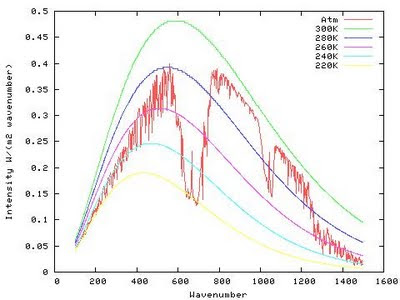A radiative transfer brain teaser
Here are two results from MODTRAN. The first is for CO2 @ 375 ppm, close to current conditions, looking down from 70 km. It is the default condition for the applet maintained by David Archer at the University of Chicago, and it will be the takeoff point for a number of comments at Rabett Run in the next couple of weeks, including some material translated from Klimakrise. Much of the argument will be taken from David Archer's Understanding the Forecast, a fine gift of the season.

The question is why does that hole appear in the center of the CO2 absorption
For those of you who need a hint, click through to the rest of this post. 
Now some of you will ask, why use such an unrealistic CO2 mixing ratio? Although Rabett Run has been steering clear of the recent unpleasantness, it is this sort of forcing extremes that scientists use to learn about nature and code (btw, what you see above has a physical basis, not a computational one).
Anyone want to play?
UPDATE: The answer has been posted
Thursday, December 03, 2009
Subscribe to:
Post Comments (Atom)





9 comments:
I'll observe that 37,500 is indeed possible. And it probably was experienced early in earth history. On the other hand, at the time, the sun was only 70% its current brightness.
Most of that extra carbon is locked up in carbonate rocks now, rather than fossil fuels. So it's unlikely we'll be returning it to the atmosphere. (Hm, now that I mention it, ocean acidification offers a route to returning the continental shelf carbonate deposits, or at least some part of them, to the atmosphere.)
Eli would negotiate down to 37,500 WAS possible.
Here's a guess:
At the line center, the absorption is so strong that the population of the ground (v=0) and excited (v=1) bending vibration become nearly equal, and the lower atmosphere becomes nearly tranparent.
In the wings, the absorption is less, and so the level populations don't equalize.
-John Farley, UNLV
Nice discussion of the meaning of the spectra. Fans of G&T scientology should note that observations of Earth spectra confirm just the shape you expect from the radiation model, so if there's any problem with the greenhouse effect, the Earth hasn't heard about it yet!
Extrasolar planet people want to use the blip at the center of the CO2 band to tell when you have a hot stratosphere, since that's a possible signature of ozone. And where you have ozone, you have oxygen. And that means we can breathe!
To be more exact regarding your high CO2 case, though, once should note that the atmospheric temperature structure is not invariant. If you put in that much CO2, it would cool down the stratosphere greatly, and would eliminate most or all of the blip.
I'm tempted to say the radiative effect of CO2 on the stratosphere pulls a neat trick to "hide the blip," but I'm afraid somebody will steal these comments and quote them out of context.
--Raypierre
Ray gave a little too much of a hint there! I will note that even in the 375 ppm case there is a narrow peak in the middle of the 600-800 and around 1100 wavenumbers.
So presumably all of these are emissions from stratospheric CO2, in the middle of absorption from tropospheric CO2.
I think Eli's hint with the lapse rate was the spoiler. I had no idea before that. But I was also wondering how the lapse rate would adjust if you did something that extreme.
The answer is that the central area is the Q branch, and its main line is susceptible to induced emission - i.e. the laser effect.
This accounts for its existence in normal atmospheric spectra. It is nothing to do with the temperature of the stratosphere which is the usual excuse.
PS. Eli, I doubt this reasoning will accepted without dispute so I may have to post follow ups. Forgive for being a "dug in."
Answer?; In the troposphere looking down; absorption effects dominate emission because upward travelling radiation is 'hotter' than the absorbing molecules. The reverse is true for the stratosphere. Since the saturated portion of the band is narrower in the stratosphere, increasing CO2 enhances stratospheric cooling more than it does tropospheric heating? Effect of doubling on layer heating rates.
The MODTRANS model doesn't show the CO2 emission peak until after 20 km. So I guess the bending mode emission is somehow disfavored at higher atmospheric pressures (something to do with the mean free path)(pchem was a very long time ago)?
BTW, at 3.75% CO2, wouldn't this be Venus Syndrome? The Model output says "Ground T, K = 299.7"
Post a Comment